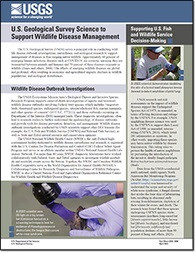
Product Details
- Product Number
- 336279
- Series
- FS-2012-3009
- Scale
- NO SCALE
- Alternate ID
- FS-2012-3009
- Authors
- KEVIN T GALLAGHER
- Version Date
- 02/01/2012
- Countries
- USA
- Media
- Paper
- Format
- Flat
Additional Details
- Description
-
Core Science Systems—Mission Overview
This product is not available for order, it can only be downloaded from here, or within the Publications Warehouse at http://pubs.usgs.gov/fs/2012/3009/
The Core Science Systems Mission Area delivers nationally focused Earth systems and information science that provides fundamental research and data that underpins all Mission Areas of the USGS, the USGS Science Strategy, and Presidential, Secretarial, and societal priorities.
—Kevin T. Gallagher, Associate Director, Core Science Systems
The U.S. Geological Survey (USGS) Core Science Systems (CSS) Mission Area spans the Earth’s “Critical Zone” (National Research Council, 2001). The Critical Zone is the near-surface interface that extends from the tops of the trees down to the base of the deepest groundwater.
CSS provides a foundation for all USGS Mission Areas, as well as for the mission of the Department of the Interior (DOI), in the following ways:
•,,Conducts basic and applied science research and development
•,,Fosters broad understanding and application of analyses and information
•,, Provides a framework for data and information sharing
•,, Creates new geospatially enabled data and information
•,, Provides technical expertise in standards and methods
•,, Provides technical expertise in standards and methods
•,,Builds and facilitates partnerships and innovation - Print Date
- 2012
- Height In Inches
- 11.000
- Length In Inches
- 8.500
- Two Sided
- Yes
- Pieces
- 1
- Languages
- English




